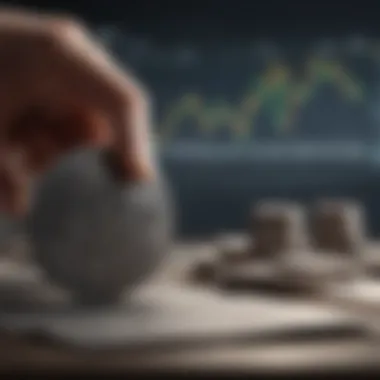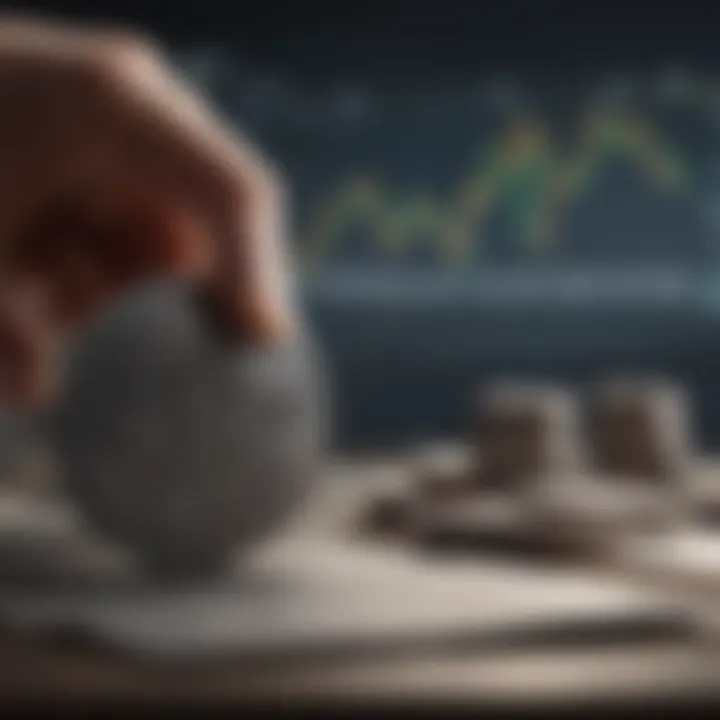Essential Insights for Investing in ETFs


Intro
Navigating the world of investing can seem as daunting as trying to find a needle in a haystack, especially with the myriad of options available nowadays. Among these options, Exchange-Traded Funds (ETFs) have emerged as a go-to choice for many investors. They provide an opportunity to invest in a diversified portfolio without breaking the bank.
But what are ETFs exactly? How do you go about buying them? And why should they even matter to you? In this guide, we will demystify ETFs, explore their benefits, and walk you through the buying process. Whether you’re a newbie just dipping your toes into investing or a seasoned guru hunting for the next big thing, this guide aims to equip you with solid knowledge to make informed decisions regarding ETFs.
Let’s dive deeper into some key terms and concepts associated with ETFs, setting the stage for our exploration.
Definitions and Terminology
Before we get into the nitty-gritty, it’s crucial to grasp some fundamental concepts surrounding ETFs. This understanding will serve as the backbone of your investing journey.
Comprehensive Investment Terms
- Exchange-Traded Fund (ETF): A type of investment fund and exchange-traded product that holds a basket of underlying assets. This often includes stocks, bonds, or commodities.
- NAV (Net Asset Value): The total value of an ETF’s assets minus its liabilities, calculated at the end of each trading day.
- Expense Ratio: This reflects what it costs an investor to run an ETF. It usually includes management fees and other costs.
Common Financial Jargon
- Liquidity: The ease with which an asset can be bought or sold in the market without affecting its price. ETFs generally feature high liquidity due to the nature of their trading on exchanges.
- Diversification: Spreading investments across various financial instruments, sectors, or asset classes to reduce risk. ETFs inherently offer this by holding multiple assets.
- Creation Units: Large blocks of ETF shares often traded by institutional investors, which help maintain the liquidity of ETFs in the market.
Understanding these basic terms will put you on a firmer footing as we continue exploring more intricate aspects of ETFs. Next, let’s look at some expert advice on investing in ETFs, both for novices and seasoned investors.
Expert Advice
With a foundation laid out, let’s delve into some strategies tailored to meet the varying experience levels of investors.
Strategies for Beginner Investors
- Start Small: Dip your toes in with a small investment. This way, you get used to how values fluctuate without risking a significant amount.
- Research, Research, Research: Look into various ETFs available. Understand their holdings, performance history, and expense ratios.
- Consider a Target-Date ETF: Such funds automatically adjust their asset mix as the target date approaches, which can be a simpler option for beginners.
Advanced Techniques for Seasoned Investors
- Sector Rotation: Keep an eye on economic cycles and shift your investments accordingly to take advantage of sector performance trends.
- Utilize Options: If you are up for advanced strategies, consider trading options on ETFs to hedge your positions or enhance returns, but ensure you fully understand the risks involved.
- Tax-Loss Harvesting: Offset capital gains by selling losing ETFs strategically to minimize your tax liability.
Remember: Investing in ETFs isn’t a one-size-fits-all approach. Evaluate your financial goals and risk tolerance to make choices that align with your personal situation.
This journey through ETFs is just beginning. Understanding their intricacies can enable savvy investing, ultimately leading to smarter financial choices. Keep reading as we further explore how to navigate the buying process in the next sections.
Understanding ETFs
Understanding Exchange-Traded Funds (ETFs) is paramount to making informed investment choices. As a hybrid investment product, ETFs combine the flexibility of trading like a stock and the diversification of mutual funds. For newcomers and seasoned investors alike, grasping the concept of ETFs can illuminate numerous paths for achieving your financial goals. They enable a wider reach into various sectors and asset classes, giving you a broader canvas to craft your portfolio.
Definition of ETFs
ETFs are investment funds that hold a basket of assets – be it stocks, bonds, commodities, or real estate. Unlike mutual funds, they trade on an exchange, just like individual stocks, which means you can buy and sell them throughout the trading day at market prices. Essentially, an ETF gives the investor exposure to a collection of assets without needing to purchase each one individually.
History and Evolution of ETFs
The concept of ETFs emerged in the early 1990s, with the first ETF, the SPDR S&P 500 ETF Trust, being launched in 1993. Its purpose was to track the performance of the S&P 500 index while offering the simplicity of trading shares on a stock exchange. Since then, ETFs have evolved like a burgeoning tree, branching out into various categories based on asset classes and investment strategies. Today, the market is teeming with thousands of ETFs, catering to diverse investor needs and preferences. The growth of ETFs coincided with increasing demand for cost-effective and transparent investment vehicles, a hallmark of modern investing.
Types of ETFs
Several types of ETFs exist, each tailored to meet different investment objectives. They can primarily be categorized by their underlying assets:
Equity ETFs
Equity ETFs primarily invest in stocks, providing a gateway for investors to gain exposure to various segments of the equity market. These ETFs can be focused on specific sectors such as technology or healthcare or track broader indices like the Nasdaq or the Russell 2000. The key characteristic of equity ETFs is their liquid nature, which allows for easy entry and exit, making them a favored choice among investors looking for growth. However, the inherent volatility of equity markets can result in substantial fluctuations in value, thus presenting a risk that investors must manage.
Bond ETFs
Bond ETFs are designed to include a portfolio of bonds, ranging from government to corporate types. They are an ideal choice for those looking for fixed income pathways and stability, often serving investors who want to buffer against stock market volatility. Since bond ETFs trade on exchanges, they offer liquidity and the ability to adjust holdings more readily than traditional bonds. On the downside, it’s essential to consider interest rate fluctuations, as this can impact their value significantly.


Commodity ETFs
Commodity ETFs provide exposure to physical goods, such as gold, silver, or oil, making them attractive for those wanting to hedge against inflation or economic downturns. The unique feature of commodity ETFs is their ability to diversify investments beyond traditional stocks and bonds, adding another layer of protection to a portfolio. Yet, commodities can be influenced by external factors like geopolitical events or changes in supply and demand, leading to an unpredictable performance.
Sector and Style ETFs
Sector and style ETFs focus on particular industries or investment styles like growth or value investing. By honing in on specific sectors, investors can align their portfolios with market trends. These ETFs are advantageous for targeting high-growth areas but may lack the inherent stability of diversified funds. A concentrated approach could amplify gains but also exposes investors to sector-specific risks, making research crucial before diving in.
International ETFs
International ETFs offer a way to invest beyond domestic borders, providing access to global markets. They can encompass developed markets, emerging markets, or a mix of both, catering to those keen on geographical diversification. This category of ETFs allows investors to take advantage of growth potential in foreign economies. However, currency fluctuations and political instability can introduce volatility, which investors must consider when evaluating these options.
Reasons to Buy ETFs
Investing isn’t just about throwing money at the wall and seeing what sticks; it's about strategy and making informed choices. When considering the assortment of investment options available, Exchange-Traded Funds (ETFs) shine brightly as a stellar option. This section will delve into several reasons that make ETFs a smart choice for investors of all stripes, from novices to seasoned pros.
Cost Efficiency
Cost is often the elephant in the room when discussing investments. ETFs typically have lower expense ratios compared to traditional mutual funds. What does that mean? Simply put, the fees associated with managing ETFs are less, meaning more of your money stays invested rather than vanishing in management costs.
For example, while a typical actively managed mutual fund might charge a fee of 1% or more annually, many ETFs sport expense ratios below 0.5%. That excess cash can compound over time, leading to a significant impact on total returns. You might think, "A half percent doesn’t sound like much," but over years, that adds up.
Diversification Benefits
The old saying goes, "Don't put all your eggs in one basket." It’s wise advice, especially in investing. ETFs allow you to spread your risk across a variety of assets, even with a limited investment amount. Want exposure to the technology sector? You can buy a tech-focused ETF instead of purchasing shares in multiple individual companies like Apple or Microsoft.
With just one transaction, you get a portfolio of stocks – a true smorgasbord of investments without requiring a hefty capital outlay. This kind of diversification not only lowers the risk but can also smooth out returns over time. Remember, it’s about playing the long game, and ETFs make it easier.
Liquidity and Flexibility
One of the most appealing aspects of ETFs is their liquidity. They trade on major exchanges, not unlike stocks, which means you can buy or sell shares any time the market is open. This gives investors the ability to react quickly to market changes or to capitalize on unexpected opportunities.
ETFs also offer flexibility when it comes to investment strategies. Whether you’re long on a sector or trying to hedge against downside risk, there’s likely an ETF that fits the bill. The chance to move in and out of positions easily means you're not locked into an investment for an extended period. This dynamism can be vital in fast-paced market environments.
Tax Efficiency
Tax considerations can sometimes feel like a can of worms, but ETFs are generally favored for their tax efficiency. When compared to mutual funds, ETFs often incur fewer capital gains taxes due to their unique structure. This is because they typically don’t distribute as many capital gains to shareholders, a virtue that funds more often indulge in.
When you sell ETF shares, you're only taxed on the gains since your purchase, unlike mutual funds, which may pass on taxable distributions even if you haven’t sold any shares yourself. For the astute investor, this difference can lead to significant tax savings over time, making ETFs a favorable option for those looking to maximize after-tax returns.
Investing in ETFs may help you keep more of your earnings in your pocket, which is always a good thing.
The Buying Process
Navigating the buying process of ETFs can feel like trying to find your way through a maze, especially for newcomers. This section focuses on the concrete steps that outline how to effectively buy ETFs, which is fundamental for any investor looking to expand their portfolio. Knowing how to open a brokerage account, place a buy order, and understand order types will equip you with the tools necessary to make informed decisions.
Opening a Brokerage Account
The first step in acquiring ETFs is to open a brokerage account. This account serves as your gateway to the stock market, allowing you to buy and sell various financial instruments, including ETFs. When choosing a brokerage, consider factors such as fees, account minimums, and whether the platform offers features that suit your investing style. Different brokerages cater to different types of investors; some may offer robust research tools, while others may provide a low-cost experience suitable for casual investors. For beginners, choosing a user-friendly platform can make a notable difference in your confidence level and ease of navigating investments.
Placing a Buy Order
Once your brokerage account is set up, you’ll need to place a buy order for the ETF of your choice. There are several methods to do this, which can cater to varying trading strategies and risk tolerance.
Market Orders
Market orders are like a fast track to buying an ETF. When you place a market order, you are agreeing to buy the ETF at its current market price. One key characteristic of market orders is their immediacy. They get executed quickly, assuming there's sufficient liquidity in the market. This makes them a popular choice, particularly for investors who want to jump in on an opportunity right away. The unique advantage here is speed; however, you do run the risk of the market price fluctuating between the time you place the order and the time it executes, potentially leading to unexpected costs.
Limit Orders
Limit orders offer a more strategic approach compared to market orders. When you place a limit order, you specify the price at which you want to buy the ETF, meaning your order will only execute if the market reaches that price. This can be beneficial if you're looking to buy an ETF at a bargain. The key aspect is control over the purchase price. Though you might miss out on certain opportunities, the assurance that your order will only execute at or below your designated price can be a comforting thought, especially in volatile markets. Remember that there’s always the possibility the market doesn’t hit your limit price, leaving your order unfilled.
Stop Orders


Stop orders, often used as a safety net, can help investors protect their capital. With a stop order, you outline a trigger price; once the ETF reaches that point, your order turns into a market order. The significant characteristic of stop orders is their usability in both buying and selling, but for our context, let's focus on buying. They can be beneficial for investors who want to enter a position only after a certain level of price stability has been confirmed. However, just like market orders, they can expose you to price shifts between the trigger point and execution, so caution is advisable.
Understanding Order Types
Understanding order types goes hand in hand with placing your buy order. Knowing when and how to use market, limit, and stop orders can significantly affect your investing success. Each order type has its pros and cons, and the best approach often depends on your specific strategy, goals, and the current market environment. For example, a market order is efficient for immediate purchases, while a limit order provides price control. On the flip side, a stop order can function as a precaution, safeguarding against unexpected market moves.
In their proper context, these order types not only improve your chances of making wise buys but also enhance your overall investing strategy, affording you the opportunity to navigate the stock market with more confidence and precision.
Factors to Consider When Buying ETFs
When you think about diving into the ETF market, it’s crucial to have a grip on several factors. These elements will shape your investment experience and determine how well your portfolio performs. This chapter explores some important points to weigh carefully when looking at different ETF options.
Expense Ratios
Expense ratios are the fees an ETF charges for managing your investment. Think of it as a toll for riding on the investment highway. Lower expense ratios can mean more money in your pocket in the long run. Even a tiny difference in fees can snowball into a significant sum over time. For instance, an ETF with a 0.1% expense ratio compared to one with 1.0% might seem minor at first. However, over several years, the difference can be substantial.
Additionally, some ETFs will not mention hidden costs, such as trading fees or performance fees. Always get the full picture by checking the prospectus and other documents.
Performance History
The past performance of an ETF is like looking at a map of where you've been. While it's not a crystal ball for future outcomes, it does provide insights into how the fund reacted during different market situations. Consider factors such as returns during bear and bull markets. If an ETF has consistently weathered storms well, it might be a safer bet for your investments than one with sporadic results.
That said, don't fall into the trap of only chasing past returns. Understand that sometimes strategies change, and just because an ETF did well historically doesn't guarantee it will keep shining in the future.
Underlying Holdings
ETFs are not monolithic; they consist of individual securities that can be stocks, bonds, or other assets. By scrutinizing the underlying holdings, you’ll uncover the ETF's true nature. For instance, if an ETF claims to focus on technology but is heavily invested in underperforming tech stocks, that’s a red flag.
Make sure to review the top ten holdings, sector weightings, and how closely it aligns with your investment goals. Knowing what’s under the hood will empower you, giving clarity on where your money is going.
ETF Management Style
The management style of an ETF can significantly impact its performance and your investment objectives. Here’s where you can draw a line between active and passive management.
Active Management
Active management is akin to hiring a skilled driver to chart your path through the unpredictable terrain of investments. Fund managers regularly buy and sell securities based on their research. This can potentially lead to higher gains, especially in volatile markets. However, it also comes with higher fees and sometimes may not outperform its benchmark after fees are taken into account. Still, for those willing to keep tabs on market movements, active management might be appealing, especially in sectors where expertise can shine, like emerging technologies.
Passive Management
Conversely, passive management is like setting your cruise control for a smooth ride. It typically aims to replicate the performance of a market index rather than beat it. Often characterized by lower fees, passive ETFs can be an excellent choice for investors seeking long-term growth without the regular tweaking seen in active management. They require minimal effort, making them popular among set-it-and-forget-it investors. However, you might miss out on maximizing gains if the market takes a turn. It all boils down to your personal investment philosophy and risk tolerance.
Remember: Factors to consider when buying ETFs are not just numbers; they shape the narrative of your financial future. Understanding these components will enhance your ability to make informed choices in an ever-evolving market.
Investment Strategies for ETFs
When delving into the world of exchange-traded funds, understanding various investment strategies is crucial. This section discusses how to maximize gains by tailoring one’s approach to individual financial goals and risk tolerance. Crafting a suitable strategy not only helps to streamline investment decisions but also offers a clear direction in the often turbulent waters of market fluctuations. By equipping oneself with diversified strategies, investors can seize opportunities while mitigating drawbacks.
Long-Term Investing
Long-term investing in ETFs typically involves holding onto investments for several years, or even decades. This approach is akin to planting a tree and nurturing it to maturity. Here’s why this strategy might resonate with numerous investors:
- Compound Growth: Patience pays off. Reinvesting dividends can set the stage for exponential growth over time. As the saying goes, "time in the market beats timing the market."
- Reduced Stress: Long-term investors are less likely to react impulsively to market dips. Instead, they focus on long-range goals, which ultimately can lead to a more serene investment experience.
- Tax Benefits: Holding assets for longer periods can help investors avoid short-term capital gains taxes that come into play with frequent trading.
When long-term investing, one might consider targeting broad market ETFs that encompass various sectors for greater diversification. Just like one wouldn't single out a single crop for one’s food supply, it’s beneficial to spread bets across multiple sectors through diversified ETF options.
Short-Term Trading
On the other hand, short-term trading in ETFs is like a quick sprint rather than a marathon. Quick gains can be attractive, but so can the pitfalls. Here’s what to keep in mind:
- Market Timing: Short-term traders often seek to capitalize on price fluctuations that can happen in mere hours. As markets can turn on a dime, being in the know is critical.
- Technical Analysis: Many short-term strategies rely heavily on chart patterns and technical indicators rather than fundamental analysis. This approach can require advanced know-how and constant monitoring.
- Liquidity: Not all ETFs are created equal. Focusing on highly liquid ETFs is crucial, as it ensures that trades can be executed swiftly without significant price slippage.


With this strategy, it’s vital to have a clear exit strategy and a set of parameters for when to enter and exit trades. Trading styles can vary from day trading, where positions are opened and closed on the same day, to swing trading, taking advantage of trends over a period of several days.
Using ETFs for Hedging
Hedging is an essential tool in the arsenal of savvy investors looking to protect their portfolios. Utilizing ETFs for hedging can serve several purposes:
- Risk Mitigation: By pairing an investment with another that moves inversely, one may shield against potential losses. For instance, if an investor holds equities in a volatile sector, they might consider investing in a bearish ETF that mirrors that sector.
- Cost Efficiency: Hedging with ETFs can be far less expensive compared to other traditional methods. No need to buy costly options or futures.
- Flexibility: Unlike individual stocks, ETFs allow for a broader reach. An investor can hedge against various sectors or asset classes with a single instrument, thereby achieving a level of control over their entire investment strategy.
In sum, choosing the right investment strategy for ETFs is contingent upon an individual's financial circumstances and market outlook. By assessing one’s risk tolerance, investment horizon, and overall goals, each investor can carve out their own unique approach to efficiently navigating the ETF landscape.
Common Pitfalls in ETF Investing
Investing in ETFs can be a rewarding venture, but it's not without its snares. Navigating through the investment landscape comes with its fair share of bumps and hurdles, and understanding these common pitfalls can significantly enhance your investment experience. By being aware of possible mistakes, both novice and seasoned investors can make more informed decisions. Avoiding pitfalls creates a better foundation for positive outcomes, allowing investors to harness the potential of ETFs more effectively.
Overtrading ETFs
One of the most tempting dangers investors face is overtrading. With ETFs being traded just like stocks, it can be all too easy to approach them with a day trader's mentality. Numerous transactions may seem harmless at first but can lead to a heap of transaction costs. For instance, if you’re bouncing back and forth between several different ETFs within a short period, soon you'll notice how those small fees can pile up and eat into your returns.
Moreover, overtrading can often lead to rash decisions driven by impulse rather than solid strategies. Investors might react to every market swing, missing the advantage of a long-term strategy. The key is finding a balance—planning trades carefully and sticking to a strategy can help in avoiding this pitfall. Keep in mind that ETF investing should align with your overall investment goals, rather than involving constant buying and selling.
Ignoring Tax Implications
Taxes can make or break an investment's returns, yet some investors slip into the trap of overlooking them. When selling ETF shares, capital gains taxes can apply, and dealing with these taxes can be complex. This aspect becomes even more crucial for investors who buy and hold ETFs in taxable accounts. For example, realize that items such as dividends and capital gains distributions can lead to unexpected tax bills, which you need to consider before making your investment decisions.
Strategies like holding onto your ETFs long-term can mitigate tax burdens. Also, consider tax-efficient ETFs, which may use strategies designed specifically to minimize distributions. Understanding tax implications shows thoroughness in planning your investment approach and helps you remain compliant with regulations.
Always bear in mind: Ignoring tax implications could result in a much smaller return than anticipated, undermining your investment strategy significantly.
Chasing Performance
Another pitfall to sidestep is chasing after top performers. Many investors tend to invest in ETFs that have recently shown impressive returns, thinking they’ve struck gold. With the myriad of options available, it might be enticing to glance at past performance metrics. However, past results do not guarantee future performance — this is a critical principle in investing.
Chasing performance can lead to a portfolio full of hype-driven investments that lack quality. Instead, focus on your overall investment strategy, including how ETFs fit in with your broader goals. Conduct thorough research on any ETF’s fundamentals rather than being swayed by impressive short-term numbers. In other words, it’s important to look below the surface—a high-flying ETF today may crash tomorrow. Prioritize sound investments and strategic alignment over momentary attractions in the market.
By recognizing these common pitfalls—overtrading, ignoring tax implications, and chasing performance—you’ll position yourself to make better, more informed decisions in the ETF realm. Incorporating diligence and strategic foresight can help pave a path toward successful investing.
Resources for Further Learning
Understanding and investing in ETFs is a journey that doesn't stop at just knowing the basics. For both novice and seasoned investors, diving deeper into the world of Exchange-Traded Funds requires a well-rounded array of resources. Having access to quality materials enhances knowledge retention and understanding and could lead to more informed investment decisions. The right resources can clarify intricate details, present varied opinions, and sharpen the investor's acumen.
Books on ETF Investing
Books are a timeless resource that can significantly contribute to your investing knowledge. They offer in-depth insights that might not be covered in articles or online sources.
Notable titles like "The Little Book of Common Sense Investing" by John Bogle delve into index investing, laying a solid foundation for understanding ETFs. Another worthwhile read is "Bond ETFs for Dummies" which focuses on bond ETFs, providing clear explanations about their mechanics and advantages. You can certainly find useful guidance within pages packed with examples, charts, and historical context that provides a broader picture of how to effectively utilize ETFs in a portfolio.
- Benefits of reading books:
- Comprehensive insights on ETF strategies.
- In-depth explanations of complex topics.
- Exposure to various expert opinions and experiences.
Online Courses and Webinars
As the digital age progresses, online education has become a prime source for financial learning. Various platforms offer specialized courses focusing on ETFs that cater to different levels of expertise. Websites like Coursera or Udemy provide courses from accredited professionals, designed to boost understanding of both theoretical concepts and practical applications.
- Advantages of online courses and webinars include:
- Flexibility in learning pace and timing.
- Interactive Q&A sessions to clarify doubts instantly.
- Networking opportunities with fellow learners and instructors.
Online mediums also frequently present webinars led by experienced financiers, which can be a goldmine for the curious investor. These sessions often reflect current market trends or case studies, giving you real-time applications of what you learn.
Investment Community Forums
Sometimes, the best knowledge comes from a community of like-minded individuals. Platforms like Reddit host numerous forums where investors discuss their strategies, share experiences, and provide insights. These communities can be invaluable for asking questions or getting feedback about specific ETFs or investment strategies.
Participating in these discussions allows you to:
- Gain various perspectives.
- Stay updated on market trends and sentiments.
- Find recommendations based on firsthand experience.
Forums also breed a sense of camaraderie, as members support each other in their investment journeys. Knowledge grows exponentially when shared among peers, making these spaces crucial resources for all types of investors.















